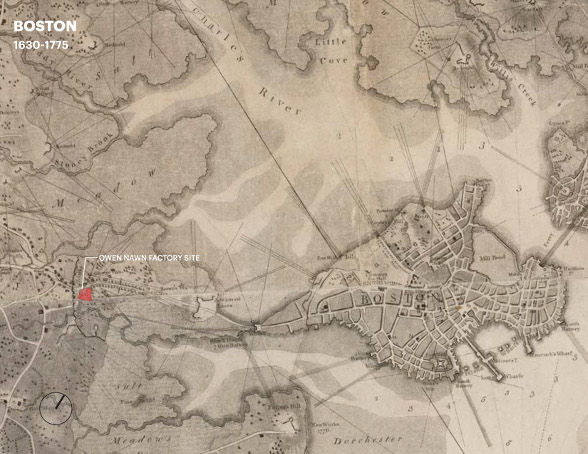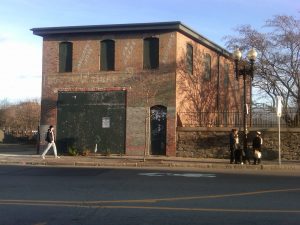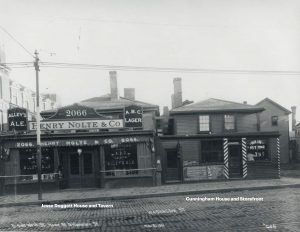
April 3, 2017 History Inspires the Future of Roxbury’s Nawn Factory
MASS Design Group is working on conceptual studies for the restoration and re-use of the 1880s Owen Nawn Factory, a building at the entry to Dudley Square that has been empty for nearly five decades. MASS project architect Alicia Ajayi describes research conducted by the firm that tells the strategic importance of the building and its place over the course of Roxbury history.
At a glance, the Owen Nawn Factory, located at the intersection of Washington Street and Melnea Cass Blvd. in Roxbury, may seem like an insignificant building on its last breath. The front facade of the building, which is the most visible side from Washington Street, shows traces of the original arched windows and an entryway with a more contemporary storefront, both of which are boarded up with plywood. This plywood is often plastered with movie posters– a symbol of subtle disregard for the significance of this structure. However, the Nawn Factory marks a site rich with history that should be preserved, honored and respected.
When HBI invited MASS Design Group to help envision the potential for revitalizing the Nawn Factory, we humbly accepted. Revitalization of the Owen Nawn Factory leverages the site?s rich history and geographical significance by expanding economic opportunity through housing, retail and commercial applications, and preserving and interpreting Roxbury’s community identity for the public.
The Nawn Factory’s historic location was a critical access point to Roxbury as early as the 1600s when Boston was a peninsular town and only connected to the mainland by a narrow strip of land known as the Boston (or Roxbury) Neck. Early settlers traveled along the road we know today as Washington Street to get in and out of the Boston for trade and other civic activities. The Eliot Burying Ground was installed almost immediately after the settlement of Roxbury in 1630, and during the Revolutionary War, this site became a strategically located stronghold as the Colonists constructed military fortifications there to evade British soldiers. Shortly after the war, the site was home to two 18th century houses, the Doggett and Cunningham houses which had a bowlin g alley and tavern at one time, and which survived into the 1980s.
g alley and tavern at one time, and which survived into the 1980s.
By the time the Nawn Factory itself was built in 1880s, this area was in a predominantly industrial zone at the northern edge of Roxbury. Over time, the building housed many different manufacturing businesses such as a blacksmith, carpenter, and cigar factory.
During the height of urban renewal in Boston in the 1960s, the city made plans for the Inner Belt Highway, a major transportation project that would connect parts of the city and surrounding areas. As demolition was taking place through the neighborhoods of the South End, Roxbury, and Jamaica Plain, community members and activists across these neighborhoods protested the project claiming that it would destroy the scale and connections of Boston’s neighborhoods. Original plans for the highway would have required demolition of the Nawn Factory and come dangerously close to the fragile Eliot Burying Ground. As it was, by the time the project was canceled in 1971 a portion of the neighborhood northwest of the Nawn Factory, been cleared. This swath of land later became Melnea Cass Boulevard, named for the beloved Roxbury civil rights activist.
Today, the corner of Melnea Cass Boulevard and Washington Street — and the long-vacant Nawn Factory — are barely noticeable, hidden by a chain link fence on the north-western boundary which also obscures the mainly empty lot and the Nawn’s long historic facade. To the south, the Eliot Burying Ground shares a wall with Nawn marking the original topography of the area. The Nawn Factory building itself, stands as only a third of its original volume due to an unfortunate fire that claimed the back portion of the building in the 1990s.
While today’s landscape is the direct result of the last two century’s land filling and urban renewal projects, little remains to tell the 17th and 18th century story of Roxbury’s once strategic importance as the sole land-based gateway to Boston, nor its 18th century story as location of Patriot fortifications during the Seige of Boston, nor the 20th century activism of Roxbury residents whose voices shut down a flawed public project in the 1960s and preserved the neighborhood’s interests.
MASS Design is helping HBI explore ways that the design for the Nawn Factory’s renewal can achieve maximum positive impact for Roxbury today. This goes beyond executing a building restoration. The community’s heritage and historic buildings should be the touchstone for shaping modern Roxbury and can be the catalysts for achieving the surrounding community’s development goals.



